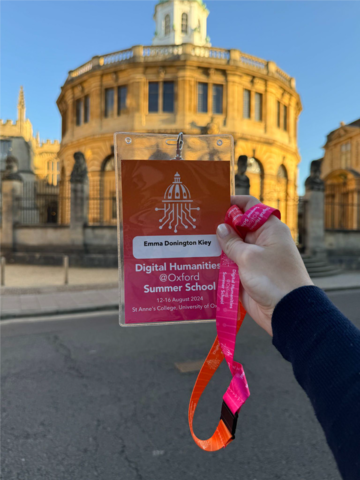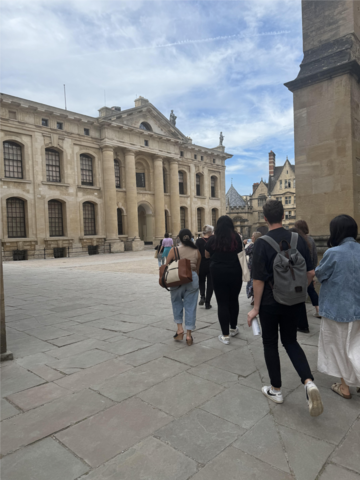Emma Donnington Kiey was awarded a bursary to attend the Digital Humanities Oxford Summer School in 2024. To join the mailing list and learn about the next summer school sign up here. Read about Emma's experience at the summer school here:
For one week in August, I had the opportunity to attend an in-person, one-week summer school at the University of Oxford in Digital Humanities. I was awarded a galleries, libraries and museum bursary for my background working with heritage institutions, and I applied to study on the summer school’s TEI strand. Although I have no formal qualifications in digital humanities it is a perspective and skill I find is becoming essential to so many aspects of museum practice, and it is also something I enjoy learning about which is a definite plus!
I participated on their TEI strand, the longest running course offered by the summer school, to learn the practical components of beginning my own project with TEI and also to become more familiar with TEI’s application in different digital scholarship projects. It was an intensive and immersive week of learning in Oxford, one that has helped shaped my existing research and inspired future study. After arriving at St. Anne’s College the summer school on a beautiful summer morning (and one of the hottest of the year), the week quickly began with a fascinating opening keynote from Andrea Wallace and then soon after hit the ground running in our course-specific classes.

Photo by Emma Donnington Kiey
On each day of the course, we focused on a different aspect of TEI and how it can be helpful to different textual mediums such as manuscripts, correspondence and plays. We began with the fundamentals of TEI and XML, and its versatility depending on your research priorities. From the beginning we were encouraged to think about our own projects and research questions. Then throughout the week we used more and more complex tags, learned how to build our own headers in Oxygen and specify our own TEI schema. I left everyday my head brimming with new ideas and considerations for my own project!
At the end of each day there were various extracurriculars organised for students to network, learn more about the university and city, and have fun! While I’ve visited Oxford before, this was the first time I imagined myself as a student, learning more about the Bodleian library, all the many colleges and rich history of the city. There was a wonderful atmosphere among the students too during our walking tour, evening dinner at St. Hilda’s college, and poster competition to name a few of the activities we all could do together.

Photograph by Emma Donnington Kiey
After the summer school, I have been able to share what I learnt with my colleagues at the Royal Botanic Gardens, Kew where I work on the digitisation of their Herbarium and Fungarium specimens. I gave a short presentation on the fundamentals of TEI and a number of TEI projects I was introduced to that were related to natural history and botany, including the Charles Darwin Correspondence and ‘Transcribing together’, a project to transcript the notebooks of ecologist, Oliver Rackham. I hope that I can continue to promote what I have learnt on the summer school, and encourage others in heritage to collaborate and engage with the digital humanities as a whole. I also wrote an article for the academic magazine Digital Orientalist on the project I am aiming to develop using TEI: to enhance the transcriptions of zoologist and Japanologist, Edward Sylvester Morse. It is so exciting that this short week at Oxford has opened up doors for conversation, research, and practical application of TEI that could continue in my career for a very long time.
Thank you to everyone who was involved in making the summer school at Oxford possible, the teachers and course leaders, and the guest speakers and keynotes, and also of course my inspiring coursemates! It was truly an incredible week at the University of Oxford that was so uniquely immersive in the digital humanities.